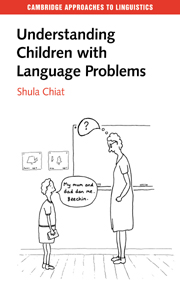Book contents
- Frontmatter
- Contents
- Acknowledgements
- Glossary of text conventions and symbols
- Introduction
- Part I Problems with words
- Part II Grappling with verb structure
- 7 Translating events
- 8 Growing verb structures
- 9 Shortfalls with verbs
- 10 ‘Thing out. Tip in there’: problems with verb processing
- Part III Missing function morphemes
- Part IV Hidden meanings, baffling meanings
- Endpoint and springboard
- Further reading
- References
- Index
10 - ‘Thing out. Tip in there’: problems with verb processing
Published online by Cambridge University Press: 05 September 2012
- Frontmatter
- Contents
- Acknowledgements
- Glossary of text conventions and symbols
- Introduction
- Part I Problems with words
- Part II Grappling with verb structure
- 7 Translating events
- 8 Growing verb structures
- 9 Shortfalls with verbs
- 10 ‘Thing out. Tip in there’: problems with verb processing
- Part III Missing function morphemes
- Part IV Hidden meanings, baffling meanings
- Endpoint and springboard
- Further reading
- References
- Index
Summary
Travis has much in common with the children we followed up in chapter 6. He too comes across as a bright, responsive child who interacts well with other people. He takes turns in conversations, and his contributions befit the context. Pragmatically, he is on the ball. But when we home in on the specific content of his utterances, we start to notice problems. These problems also show up in formal tests of his language. At 6, he performs at the level of a 4- to 4½-year-old in tests of word and sentence comprehension:
British Picture Vocabulary Scales (BPVS): scored at age level 4;1
Test for the Reception of Grammar (TROG): scored at age level 4;6
In contrast, his score on a test of non-verbal intelligence is average for his age. Like the children presented in chapter 6, Travis shows particular difficulties when it comes to dealing with words and combinations of words. In presenting Travis's case, however, the spotlight will move from words in general to the particular words needed to express events, namely verbs and their arguments. Our purpose will be to find out where, in the connections between events and verb-argument structures, Travis's difficulties arise.
Our starting-point is an event-description task which established that Travis did have particular difficulties in talking about events. In this task, Travis watched his therapist act out 127 different events. These events represented thirty verbs, which were enacted in different contexts and with different participants.
- Type
- Chapter
- Information
- Understanding Children with Language Problems , pp. 163 - 180Publisher: Cambridge University PressPrint publication year: 2000

